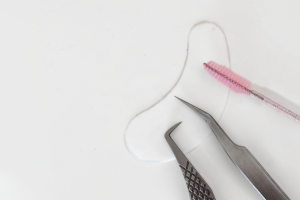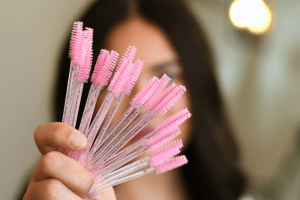Eyelashes are more than just a feature that enhances your eyes—they play a critical role in protecting them from dust, debris, and sweat. To appreciate their importance, it’s helpful to understand the science behind eyelash growth and the factors that influence it. This blog delves into the biological aspects of how eyelashes grow and what can affect their growth cycle.
Understanding the Eyelash Growth Cycle

The eyelash growth cycle comprises three main phases: anagen, catagen, and telogen. Each phase plays a distinct role in the development and shedding of lashes.
1. Anagen Phase (Growth Phase)
The anagen phase is the active growth period for eyelashes. This phase can last anywhere from 30 to 45 days. During this time, the hair follicle is firmly attached to the dermal papilla, and the cells in the hair bulb are rapidly dividing to create new hair. Approximately 40% of the upper lashes and 15% of the lower lashes are in the anagen phase at any given time.
2. Catagen Phase (Transition Phase)
The catagen phase is a short transitional stage that lasts around 2 to 3 weeks. In this phase, the hair follicle shrinks and detaches from the dermal papilla, cutting off the blood supply to the hair. As a result, the lash stops growing and prepares to shed.
3. Telogen Phase (Resting Phase)
The telogen phase is the resting stage, which can last about 100 days before the lash naturally falls out. During this phase, the old hair rests while a new hair begins to grow underneath it. Once the old hair sheds, the cycle restarts with the anagen phase.
Biological Factors Influencing Eyelash Growth
Several biological factors can influence the length, thickness, and health of your eyelashes.
Genetics
Your genetic makeup significantly impacts your eyelash growth cycle. If your parents have long, thick lashes, you’re more likely to inherit the same traits.
Age
As you age, the growth rate of your eyelashes can slow down. Hormonal changes, particularly during menopause, can also affect lash density and growth.
Hormonal Changes
Hormones play a crucial role in hair growth, including eyelashes. Conditions like pregnancy, thyroid disorders, and hormonal imbalances can alter the growth cycle of your lashes.
Nutrition
A balanced diet rich in vitamins and minerals is essential for healthy hair growth. Nutrients such as biotin, vitamin E, and omega-3 fatty acids can promote the growth and strength of eyelashes.
Health Conditions
Certain medical conditions, such as alopecia areata or blepharitis, can affect the growth and health of your eyelashes. Additionally, undergoing chemotherapy can cause eyelashes to fall out temporarily.
Medications
Some medications can have side effects that influence eyelash growth. For example, glaucoma medications like bimatoprost have been found to stimulate eyelash growth.
Environmental and Lifestyle Factors
Beyond biological factors, several environmental and lifestyle choices can impact your eyelash growth cycle.
Cosmetic Products
Using mascara, eyelash extensions, and false lashes can affect the health of your natural lashes. These products can cause breakage or allergic reactions, leading to thinner lashes over time.
Proper Eyelid Hygiene
Maintaining clean eyelids is crucial for eyelash health. Buildup of oils, makeup, and debris can clog hair follicles, impeding lash growth and causing infections.
Stress
High levels of stress can trigger hair loss, including eyelashes. Managing stress through relaxation techniques and a healthy lifestyle can support better lash growth.
Sleep Patterns
Adequate sleep is vital for overall health, including hair growth. Poor sleep patterns can disrupt hormonal balance, affecting the growth cycle of your eyelashes.
Enhancing Eyelash Growth Naturally
While understanding the growth cycle and factors affecting it is essential, there are ways to enhance eyelash growth naturally.
Nutritional Supplements
Taking supplements that contain biotin, vitamin E, and omega-3 fatty acids can support healthy lash growth.
Natural Oils
Applying natural oils like castor oil or coconut oil to your lashes can help nourish and strengthen them.
Gentle Makeup Removal
Always remove makeup gently to avoid damaging your lashes. Use a mild makeup remover and avoid rubbing your eyes harshly.
Lash Serums
Over-the-counter lash serums can promote lash growth by nourishing the hair follicles. Look for serums with ingredients like peptides and vitamins.
Conclusion
Understanding the science behind eyelash growth is key to maintaining and enhancing the beauty of your lashes. By acknowledging the biological and environmental factors that influence lash growth, you can adopt habits and routines that support healthier, fuller lashes. Whether through proper nutrition, gentle eyelid care, or natural enhancements, nurturing your eyelashes can lead to stunning results.







